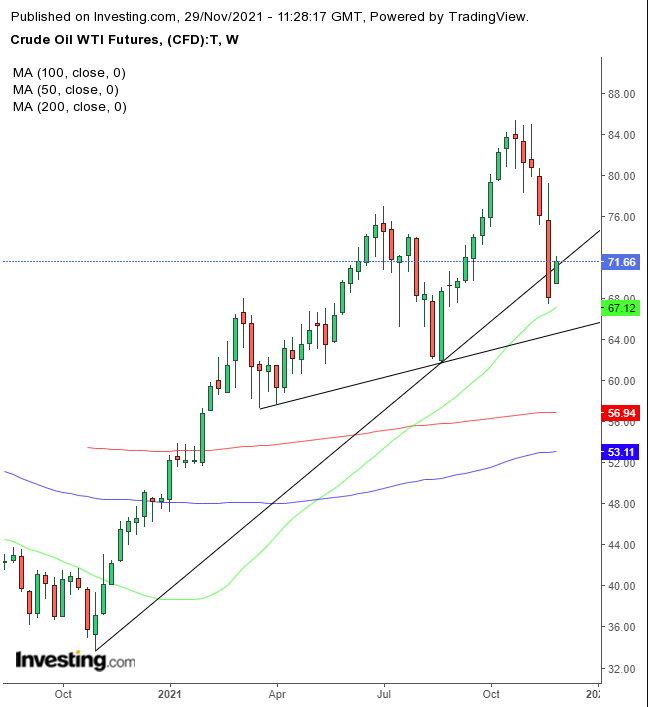After Friday's panic-induced oil selloff, during which the energy commodity dived, closing down 12% for the day, Monday's trading brought a reversal. At the time of writing, WTI has rebounded, gaining more than 5% to almost $72 a barrel. Friday's price collapse was the worst drop for crude since April 2020—during the height of the pandemic.
The plunge on Friday was triggered by trader fears that the latest COVID variant, Omicron, could be more dangerous, more infectious and harder to contain than the Delta variant as worries arose it might not be responsive to current vaccines. However, on Sunday, South African researchers who had identified the new strain, said its symptoms appeared mild.
Then, on Monday, the World Health Organization (WHO) warned that the risk related to the latest virus might have "severe" consequences for some. With that, traders likely began experiencing severe emotional whipsawing. It's a classic example of what can fuel trading. Markets may think they know what will happen, only to be blindsided by an unexpected event that flips sentiment from positive to negative or vice versa.
Here's what this risk-appetite flip-flop looks like on oil's technical chart:

This morning, crude climbed back above the uptrend line since the early-October low, below which it fell during Friday's meltdown. At the same time, the price crossed back above the 200 WMA that joined the uptrend line. Note, the 50 WMA supported the price during Friday's drop.
Below that there's another, slightly rising trend line. A slower trendline is generally the signal for a potential trend reversal. Given that oil is the primary fuel for the global economy, the current most prominent theme is how Omicron will play out. Any piece of news or rumor on that topic will likely trigger oil's next move—in either direction.
Therefore, trading this commodity at this time is not for the faint of heart. Traders should take every precaution to protect their positions.
Trading Strategies
Conservative traders should stay out of this trade due to the high degree of uncertainty, both in terms of the pandemic and technicals.
Moderate traders would wait for either evidence of accumulation or distribution, possibly with a long candle in either direction, to pick a side to the trade.
Aggressive traders could enter a long position, given that the price found support by both major MAs and the uptrend line. There is also an argument for an upward correction after a five straight day decline. If the price falls below $64, cutting through the slower uptrend line since the Mar. 22 low, they would probably short the contract. Either way, they should not make a move without a clear, strict plan. Here's a basic example:
Trade Sample
- Entry: $69
- Stop-Loss: $67
- Risk: $2
- Target: $75
- Reward: $6
- Risk-Reward Ratio: 1:3
Author's Note: This is just a basic sample. You need to write a trade plan customized to your temperament, budget and timing. Until you learn how to do so, feel free to practice with our sample, for purposes of learning, not profit. Otherwise, you'll end up with neither. Guaranteed. And there's no money back.
